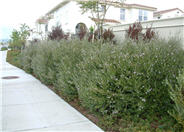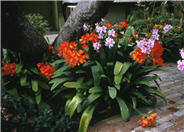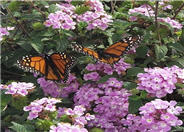
Common name:Westringia Wynyabbie Gem
Botanical name:Westringia 'Wynyabbie Gem'
This evergreen shrub will grow 3'-6' high and 6'-8' wide and has lavender flowers that bloom from February through spring. It is drought tolerant and does well in full sun or partial shade.

Common name:Kaffir Lily, Clivia
Botanical name:Clivia miniata
A clumping evergreen bulb, this Kafir Lily produces luxuriant leaves and stalks of deep orange to red orange flowers in late winter and spring. It tolerates deep shade and, after establishment, drought. The plant requires frost protection. It performs well in containers. -Monterey Bay Nursery

Common name:Trailing Lantana
Botanical name:Lantana montevidensis
Lavender flowers accent the trailing growth habit of this Lantana. It is excellent for spilling over walls or down banks. Eventually, it will reach about 2' tall by 6' wide; size is controlled by pruning and severity of winter. It does best in full sun and is drought tolerant. It grows rapidly, even in heat, smog and poor soil. It is cold hardy to 25 degrees F, but recovers quickly. Fruit is poisonous. Butterflies are attracted to Lantana.

Common name:Iceberg Floribunda Rose
Botanical name:Rosa 'Iceberg'
This is a shrub rose (there are climbing varieties) with an abundance of fragrant, medium sized, white blooms. It is one of the most popular roses and very tough.

Common name:Hybrid Tea Rose (selections)
Botanical name:Rosa Hybrid Tea varieties
These shrubs and vines are the most loved in the Western USA and are very resilient. They come in a wide variety of sizes and colors and are easy to maintain with proper care. They can be used in a water-conserving garden with careful attention to irrigation practices.

Common name:White Birch, European White Birch
Botanical name:Betula pendula
This medium-size weeping tree will grow to about 40' tall and has a whitish/brown bark with deciduous green leaves.
| Designer: Anon | Brick Path with Color |
Photographer: GardenSoft |
Soils and Compost:
Maintain a two to four inch layer of mulch on the soil surface to reduce weeds, infiltrate rain water, and reduce compaction.
Water Saving Tip:
Check the soil's moisture level before watering.
You can reduce your water use 20-50% by regularly checking the soil before watering.
Integrated Pest Management:
Drip and other smart irrigation delivers water directly to roots, allowing no excess water for weeds.

